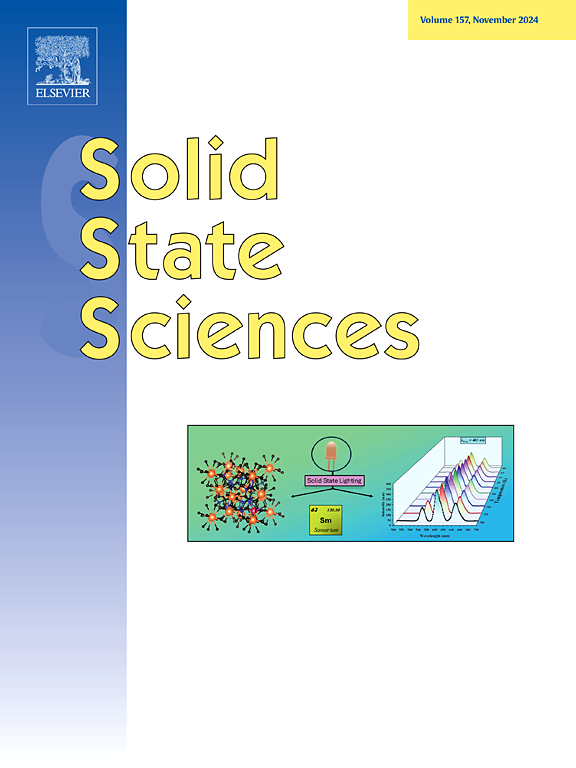Green synthesis of antibacterial Ge-Sr phosphate scaffolds enhanced with eco-friendly pore-forming agents for biomedical use
IF 3.3
3区 化学
Q2 CHEMISTRY, INORGANIC & NUCLEAR
引用次数: 0
Abstract
This study investigates the development of composite ceramics for application in hard tissue augmentation, using GeO2 and germanium-strontium phosphates as base materials. Various pore-forming agents, including cetyltrimethylammonium bromide (CTB), polyethylene (PE), caffeine (CFF), and natural materials such as lemon peel (LMN), silk (SLK), loofah (LFH), and yam (YAM), were employed to introduce porosity into the scaffolds. The impact of these agents on phase composition, particle size, and surface properties was analyzed, revealing that some agents induced phase transformations, while others preserved a multi-phase structure. The incorporation of phosphorus and strontium into the scaffolds to enhance bioactivity was evaluated using XRF analysis. The scaffolds' porosity, particularly meso- and macroporosity, was significantly influenced by the pore-forming agents. Antimicrobial activity, demonstrated against both gram-negative and gram-positive bacteria, was also an important factor for scaffolds intended for medical implants and wound healing. Among the materials tested, SGP-SLK and SGP-CTB showed the most promising results, combining excellent bioactivity, enhanced bone regeneration potential, and superior antimicrobial performance. These findings suggest that composite scaffolds incorporating phosphorus, strontium, and suitable porosity are promising candidates for tissue engineering applications.

生物医学用环保成孔剂增强抗菌锗锶磷酸盐支架的绿色合成
本研究以GeO2和磷酸锗锶为基材,研究了用于硬组织增强的复合陶瓷的发展。采用不同的成孔剂,包括十六烷基三甲基溴化铵(CTB)、聚乙烯(PE)、咖啡因(CFF)和天然材料,如柠檬皮(LMN)、蚕丝(SLK)、丝瓜络(LFH)和山药(yam)来引入支架的孔隙。分析了这些助剂对相组成、粒度和表面性能的影响,揭示了一些助剂诱导相变,而另一些助剂则保持了多相结构。利用XRF分析评价磷和锶掺入支架增强生物活性的作用。成孔剂对支架的孔隙率,特别是中孔和宏观孔隙率有显著影响。抗革兰氏阴性和革兰氏阳性细菌的抗菌活性也是用于医疗植入物和伤口愈合的支架的重要因素。在所测试的材料中,SGP-SLK和SGP-CTB结合了优异的生物活性、增强的骨再生潜力和优异的抗菌性能,显示出最有希望的结果。这些发现表明,含有磷、锶和合适孔隙度的复合支架是组织工程应用的有希望的候选者。
本文章由计算机程序翻译,如有差异,请以英文原文为准。
求助全文
约1分钟内获得全文
求助全文
来源期刊

Solid State Sciences
化学-无机化学与核化学
CiteScore
6.60
自引率
2.90%
发文量
214
审稿时长
27 days
期刊介绍:
Solid State Sciences is the journal for researchers from the broad solid state chemistry and physics community. It publishes key articles on all aspects of solid state synthesis, structure-property relationships, theory and functionalities, in relation with experiments.
Key topics for stand-alone papers and special issues:
-Novel ways of synthesis, inorganic functional materials, including porous and glassy materials, hybrid organic-inorganic compounds and nanomaterials
-Physical properties, emphasizing but not limited to the electrical, magnetical and optical features
-Materials related to information technology and energy and environmental sciences.
The journal publishes feature articles from experts in the field upon invitation.
Solid State Sciences - your gateway to energy-related materials.
 求助内容:
求助内容: 应助结果提醒方式:
应助结果提醒方式:


